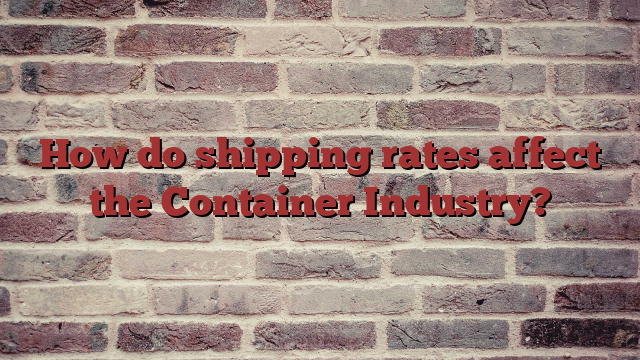The global container industry, driven by shipping containers, plays an invaluable role in global trade and commerce. These utilitarian steel boxes have transformed how goods are transported around the globe – one significant influencer being shipping rates – which we will discuss here in depth in this blog post.
Containerization and the Global Economy Containerization has long been at the heart of international trade, playing an essential role in logistics operations while cutting costs and speeding delivery times. Their modular designs enable seamless incorporation onto ships, trucks, or trains for multimodal transportation solutions.
Containerization has allowed businesses to optimize their supply chains and expand globally, contributing to an interlinked global economy. But its cost depends heavily on prevailing shipping rates.
Shipping Rates: A Pulse of the Container Industry
Shipping rates refer to the prices charged by shipping companies for transporting goods between locations. They can be affected by various factors, including supply and demand, fuel costs, geopolitical events and economic conditions – two components being freight rates and container rates.
Freight rates refer to charges associated with transporting goods while container rates address only costs associated with using shipping containers. Understanding their relationship is crucial and how changes in shipping rates could have significant ramifications on the container industry as a whole.
Impact of High Shipping Rates Its Since 2012, the container industry has witnessed an upsurge in shipping rates due to several factors. COVID-19 disruption caused imbalances in supply chains that subsequently created shortages in containers available; as such, shipping rates skyrocketed as demand exceeded supply. High shipping rates can have several damaging effects on both stakeholders and industry players:
- Increased Costs: Businesses that depend on shipping containers must bear the consequences of higher container rates, which may increase operating expenses and profit margins while passing on higher costs to consumers through higher product prices.
- Supply Chain Disruptions: High shipping rates can lead to supply chain disruptions, delays and uncertainties for businesses. They may encounter difficulty in finding available containers for shipment, leading them to use alternative transportation methods like air freight that can be significantly more expensive.
- Effect on Smaller Players: Smaller businesses and startups may find it more challenging to compete in an environment with rising shipping rates due to increased container costs posing a barrier to entry, restricting their ability to expand internationally.
- Economic Implications: High shipping rates can contribute to inflation, straining the wider economy. Increases in product costs could erode consumers’ purchasing power and lead to economic instability.
Low Shipping Rates
Conversely, low shipping rates also impact the container industry in a different way. Low rates could arise from oversupply, economic downturns or changes in trade patterns and could have negative repercussions for container trading.
- Margin Pressure: Shipping companies may experience financial difficulty when rates are too low to maintain and upgrade their container fleets effectively, leading to reduced quality and availability.
- Reduced Investments: Low shipping rates can thwart investments in new containers or the expansion of container terminal capacity, endangering its long-term health.
- Benefits to Importers and Consumers: Importers may find lower shipping rates advantageous because it reduces their transportation costs, leading to reduced prices for imported goods which ultimately benefit both parties involved.
- Stimulation of Trade: Reduced shipping rates can help stimulate international commerce as businesses find it more cost-effective to engage in international commerce, leading to higher container demand and creating a potential positive feedback loop for the industry.
Finding the Ideal Balance
For container shipping rates to function optimally, they must strike an equilibrium between economic viability for shipping companies and affordability for businesses and consumers. Achieve this balance is key for the industry’s long-term viability and smooth cross-border goods flow.
To achieve balance, various stakeholders such as shipping companies, governments and international organizations must come together. Governments can play an essential role by creating an enabling regulatory environment, investing in infrastructure development and supporting trade facilitation to better support container industries.
Strategies to Adjust to Fluctuating Shipping Rates
Businesses and individuals living in an environment where shipping rates fluctuate frequently must employ strategies in order to adapt. For example:
Diversification: Businesses should diversify their supply chains and transportation methods in order to decrease reliance on shipping containers. Employing multiple modes such as air or rail transport provides more cost control options to accommodate for cost fluctuations.
Long-Term Contracts: Securing long-term contracts with shipping companies can offer price stability even in an unpredictable market, although this may limit flexibility; nonetheless, it could protect businesses against sudden rate spikes.
Inventory Management: Successful inventory management can help businesses avoid stockouts during periods of container shortages or high shipping rates, by maintaining buffer stocks and optimizing order quantities. Maintaining buffer stock can be critical.
Collaboration: Collaboration among businesses, shipping companies and logistics providers can lead to more effective supply chains and potentially secure more favorable shipping terms.
Adopting Technology: Implementing advanced supply chain technologies such as data analytics and tracking systems can increase visibility while helping inform decisions in response to rate fluctuations.
Visit https://www.tigershippingcontainers.com.au/shipping-containers-brisbane-qld/
Profit Margins and Competitiveness:
For container shipping companies, the rates they charge have a direct correlation with their profit margins. Higher rates can enhance profitability for shipping companies, but they may also pose challenges for businesses relying on container transport. Elevated shipping costs can erode profit margins for manufacturers and impact the competitiveness of products in the global market.
Global Trade Patterns:
Shipping rates influence global trade patterns by shaping the flow of goods between countries. When rates are high, businesses may reassess their supply chain strategies, favoring regional or local suppliers to mitigate transportation costs. Conversely, lower shipping rates can stimulate international trade, fostering globalization and encouraging businesses to explore new markets.
Conclusion
Shipping rates are the backbone of the container industry, directly impacting the cost of moving goods around the globe. They impact decisions by businesses, goods movement and global economic health – which all depend on them for success. Over time, shipping companies must adapt to an ever-evolving landscape by adapting shipping rates accordingly and finding balance amongst interests amongst shippers, businesses and consumers if the industry is to continue growing and flourishing.



